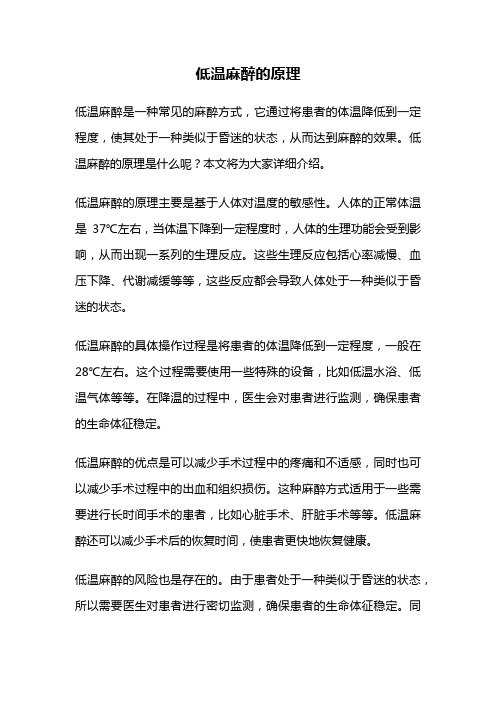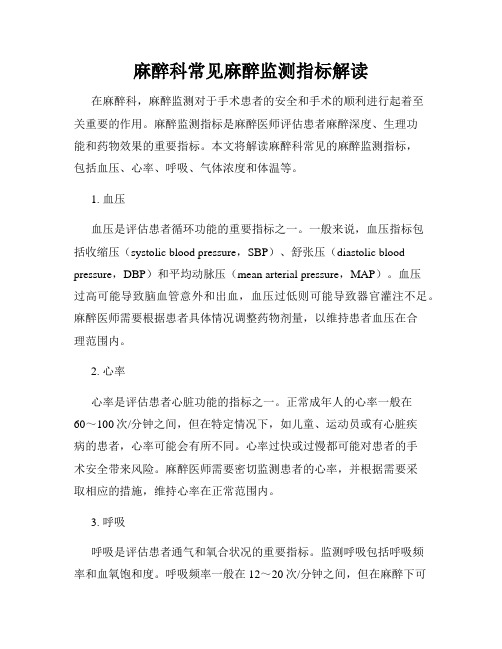麻醉对患者体温的影响
全身麻醉术中体温降低的影响因素及保温对策

喉 罩 置 入 操 作 简便 , 刺激 小 , 血 管 系统 反 应 较 轻 , 后 咽 心 术
喉痛发生率低 , 术后肺不 张、 肺炎发 生率 降低 , 目前 已广泛应 用
时间2 3 h 随机分 为干预 组与对 照组 , . , 5 对照组采 用 常规 保 温措 施 , 干预 组采取 综合保 温措施 , 别测量麻 醉 开始 、 醉后 3mi、 分 麻 0 n 6 mn 9 m n 10 i、 0 i、0 i、2 m n 手术结束时的肛温值 , 并分析 两者之 间的关 系。结果 对照组患者体温随手术时间延长显著 下降, 干预组患者 体 温下降不明显 ,组 比较 有统计学意义( < . 2 P 00 o结论 医护人 员应重视 全麻 患者术 中体温降低 的 问题 , 5 实施综 合保 温措施 , 能有
清扫 1 ; 龄2 ~ 7 , 均 年 龄 (95 1-) ; 体 手 术 患者 静 例 年 9 8床 资料 . 1 工 作 单 位 :14 0 仪 征 江 苏省 仪 征 市 人 民 医院 手 术 室 2 10 吕仲 英 : , 科 , 管护 师 女 本 主
醉 医师 。 33 拔 罩 后 护理 .
诸 多 因素 的影 响 , 易产 生 烦 躁 不 安 、 虑 、 惧 等 心 理 。 之 不 极 焦 恐 加 了解 相 关 的 医疗 知 识 , 生躁 动 、 发 自行 拔 出或 脱 出喉 罩 的情 况 较 多。 因此 , 在术 前访 视 时 应 主动 介 绍 麻 醉 过程 , 消 除 患儿 紧张 不 以 安 的情 绪 , 取得 患儿 的信 任 和 配 合 。 极 主 动 的 沟 通 等 一 系 列 护 积 理 干 预 措施 , 可使 患 儿 能够 适 应新 环 境 , 能 安 静 配 合 治疗 , 免 并 避 意 外 拔罩 的发生 , 高 护理 的 质量 。 提
术中主动保温策略及标准流程

术中主动保温策略及标准流程一、背景与意义手术过程中,由于麻醉、手术创伤、大量输血输液等因素,患者容易出现低体温。
低体温不仅影响手术效果,还可能引发一系列并发症,如凝血障碍、免疫力下降等。
近年来,术中主动保温策略逐渐受到重视,其意义在于预防和治疗低体温,保障手术顺利进行,提高患者术后恢复质量。
二、术中低体温的发生机制1.麻醉影响:麻醉药物会抑制患者的体温调节中枢,导致体温调节能力下降。
2.手术操作:手术过程中,皮肤暴露、冲洗液温度较低、手术时间长等因素都会导致热量流失。
3.环境因素:手术室温度较低、输血输液温度过低等环境因素也会导致患者体温下降。
三、低体温对机体的影响1.凝血障碍:低体温会影响血小板功能,降低凝血因子的活性,导致凝血障碍。
2.免疫力下降:低体温会降低免疫细胞的活性,增加术后感染的风险。
3.心血管并发症:低体温可能导致心律失常、心肌缺血等心血管并发症。
4.术后恢复延迟:低体温会影响伤口愈合,增加术后并发症的风险,延长患者恢复时间。
四、主动保温策略的必要性和重要性1.减少并发症:主动保温策略可以有效预防和治疗低体温,从而减少术后并发症的发生。
2.提高手术效果:维持患者正常体温可以保证手术效果,减少因低体温导致的手术风险。
3.缩短恢复时间:通过主动保温策略,可以加速患者术后恢复,缩短住院时间。
4.提高患者满意度:术中主动保温策略体现了对患者的人文关怀,提高患者的满意度和信任度。
五、保温方法与具体流程1.调节手术室温度:手术室温度应维持在24-26摄氏度,减少患者热量流失。
2.预加热输血输液:对输血输液进行预加热,减少因低温液体输入导致的热量流失。
3.使用保温毯:为患者加盖保温毯,减少皮肤暴露导致的热量流失。
4.体温监测:在手术过程中持续监测患者的体温变化,及时发现并处理低体温。
5.加热冲洗液:使用加热冲洗液进行手术部位的冲洗,减少因冲洗液导致的热量流失。
6.减少暴露时间:尽量缩短手术时间,减少皮肤暴露时间,从而减少热量流失。
麻醉期间的体温管理

环境因素对体温的影响可以通 过调节手术室温度和湿度来改 善。
患者自身因素的影响
年龄
新生儿和老年人由于体温调节机 制较弱,容易发生体温下降。
疾病状态
慢性疾病、营养不良和虚弱的患者 容易发生体温下降。
药物使用
某些药物会干扰体温调节,导致体 温下降。
03
体温管理的策略与措施
术前评估与准备
评估患者情况
保温护理
保持病房温度适宜,避免患者受凉,同时注意遮 盖裸露的部位,减少热量散失。
观察与记录
对患者的体温变化进行观察和记录,以便及时调 整护理措施和评估治疗效果。
04
体温管理的最新研究进展
新型保温设备的应用
主动加温设备
主动加温设备能够提供持续的热源, 通过电热毯、热风循环等方式,有效 防止患者在麻醉期间出现体温下降。
一位老年女性,因髋关节置换手术接受麻醉。手 术过程中出现低体温,体温降至34℃。
处理措施
医生及时采取保暖措施,如加温毯、输注加温液 体等,同时调整麻醉药物的输注速度。
3
结果
经过及时处理,患者体温逐渐回升至正常范围, 手术顺利完成,患者术后恢复良好。
高体温患者的风险防范案例
患者情况
一位年轻男性,因腹部 手术接受麻醉。手术过 程中出现高体温,体温 升至39℃。
了解药物代谢与体温之间的关系,对于合理调整用药剂量和 给药速度具有重要意义。在手术过程中,根据患者的体温变 化,医生可以适时调整麻醉药物的用量,以确保患者安全度 过手术期。
体温与管理决策
对体温的监测和管理是麻醉期间的一项重要任务。医生需要根据患者的体温变化情况,及时做出管理决策,以应对可能出现 的风险。
缩短手术时间
降低术后感染率
术中低体温的原因分析及护理进展

术中低体温的原因分析及护理进展【关键词】:低体温护理体温,通常是指人体内部的温度,其调节中枢位于下丘脑。
正常情况下,人体的腋下温度为36-37℃,低于36℃则称之为低体温,手术患者在术中发生低体温十分常见,其发生率可达60%--80%[1]。
术中麻醉药物的使用、环境温度低、保暖不当等因素均可导致患者发生低体温,低体温可对机体多个系统产生影响,影响患者术后恢复。
因此,保持患者术中体温正常非常重要。
现对术中导致低体温的因素、低体温对机体的影响、预防及护理措施综述如下,旨在有效预防和减少术中低体温的发生,降低术后并发症,提高手术中的护理质量[2]。
1.低体温的原因1.1麻醉对体温的影响。
麻醉期间体温降低与麻醉药物的使用有关[3]。
人体有完善的体温调节机制,在外界环境温度改变时,通过调节产热过程和散热过程,维持体温相对稳定。
全身麻醉时,麻醉药物抑制了机体正常的温度调节,使体温受外界温度的影响较大。
正常情况下,机体的体核温度高于体表温度2--4℃,在麻醉状态下,血管收缩的冷阈值大大降低,动静脉畸形开放,导致体热从中心到外周的重新分配,核心体温降低1~1.5℃。
另外,肌松药使全身骨骼肌处于松弛状态,消除肌紧张及肌肉运动的产热,而导致体温下降[4]。
1.2环境温度与皮肤消毒剂对体温的影响由于医患对室温要求的差异、室温调节不当或不及时使手术室温度相对较低、手术室转入恢复室的途中室外温度低于室内温度等因素均可引起体温下降。
马为梅等[5]报道,67%的病人寒战发生在冬季,提示低体温易使病人散热增加。
同时,术前皮肤消毒使用易挥发的消毒剂,如乙醇,在消毒过程中通过蒸发而使机体散热增加,如不及时调整室温,病人会出现寒战现象,使体温降低。
1.3输血输液对体温的影响手术中大量输液,特别是输入大量库存血,可明显导致低体温。
有研究报道,室温下每输入1000ml液体或200ml4℃血液,可使体温下降0.25--0.5℃[6]。
另外,术中使用大量未加温的生理盐水冲洗体腔,可导致机体热量进一步散失[7]。
麻醉科手术中的生命体征监测

麻醉科手术中的生命体征监测手术是现代医学领域中最为重要且常见的治疗方法之一。
在手术过程中,麻醉科医生起着至关重要的作用,他们负责给患者提供合适的麻醉措施,以确保手术的顺利进行。
而在麻醉科手术中,监测患者的生命体征是至关重要的一环。
一、生命体征的定义和意义生命体征是指人体在生理和病理状态下所表现出来的一些特殊指标和反应。
主要包括体温、呼吸、心率、血压等指标。
监测这些生命体征的变化有助于医生判断患者的生理状况和手术过程中的变化,及时采取相应的处理措施。
二、体温的监测和控制体温是人体内部的热量总量指标,对维持正常的生理功能非常重要。
在手术过程中,麻醉药物会对患者的体温产生影响,因此,对患者体温的监测和控制是必不可少的。
常见的体温监测方法有使用体温计测量腋下或口腔体温、贴在皮肤上的温度贴、导管放置体温探头等。
在麻醉科手术中,常常使用导管放置体温探头的方法,这种方法准确、方便,且不会对手术过程产生干扰。
三、呼吸的监测和控制呼吸是人体生命活动中的重要部分,它为人体提供氧气并排出二氧化碳。
在麻醉科手术中,呼吸监测是非常重要的一环。
通过监测患者的呼吸状态,医生可以及时发现异常情况并做出相应的处理。
呼吸的监测方法主要有观察胸部起伏、听诊呼吸音、测量呼气末二氧化碳浓度等。
其中,测量呼气末二氧化碳浓度是一种先进且准确的方法,通过将二氧化碳浓度传感器连接到呼吸机上,可以实时监测患者的呼吸情况。
四、心率的监测和控制心率是人体心脏每分钟跳动的次数,是评估人体心血管功能的重要指标之一。
在麻醉科手术中,监测患者的心率可以及时发现心律不齐、心动过速或心肌缺血等异常情况,并采取相应的处理措施。
常见的心率监测方法有使用心电图仪、多普勒超声心动图等。
在手术过程中,常常使用心电图仪来监测患者的心率。
通过将导联电极贴于患者的胸部,可以实时记录患者的心电图,并计算出心率。
五、血压的监测和控制血压是人体循环系统中的一个重要指标,反映了心脏泵血功能和血管阻力的大小。
全麻期手术患者体温变化的临床观察

中图分类 号 :R 6 1 4
文献标 识 码 :B
文章 编号 :1 6 7 1 - 8 1 9 4( 2 0 1 3 )1 2 - 0 4 2 6 - 0 2
Cl i ni c a l O bs e r v a t i o n of Ane s t he s i a S ur g e r y Pa t i e n t Te m pe r a t ur e Cha nge CHEN Xt p r i l 2 0 1 3 , V o 1 . 1 1 , N o . 1 2
全麻期手术 患者体温变化 的临床观察
陈小 明
( 安徽省宁国市医院麻醉科 ,安徽 宁国 2 4 2 3 0 0 )
【 摘 要】 目的 通过检 测体 温 分析不 同保 温措 施 对 全麻期 手术 患者体 温 变化 的影响 。方 法 选取 7 6例手 术患者 ,手 术期 问 全麻 ,随机 分至 常
t h e e n d o f s r u g e y r , t h e b o d y t e m p e r a u t r e o f he t c o n v e n t i o n a l g r o u p d e c r e a s e d b y ( 1 . 1 6 + 0 . 2 1 ) * C, t h e o b s e v r a t i o n ro g u p w a s ( 0 . 1 2  ̄ 0 . 1 8 ) ' c i n c r e a s e i n b o d y
o p e r a t e d p a t i e n t s , me a s re u d bo d y t e mp e r a t u r e e v e r y h a l f a n h o r u f r o m ne a s t he s i a , he t a n a l y s i s o f he t r e s u l t s o f t h e t wo ro g u p s we r e c o mp a r e d . Re s u l t Th e c o nv e n t i o na l g r o u p a nd o b s e r v a t i o n g r o u p a n e s he t s i a b o d y t e mp e r a t u r e n o s i g ni ic f nt a d i fe r e nc e b e t we e n h a l f n a ho ur a f t e r t h e t e mp e r a ur t e d i fe r e nc e , u n t i l
低温麻醉的原理

低温麻醉的原理低温麻醉是一种常见的麻醉方式,它通过将患者的体温降低到一定程度,使其处于一种类似于昏迷的状态,从而达到麻醉的效果。
低温麻醉的原理是什么呢?本文将为大家详细介绍。
低温麻醉的原理主要是基于人体对温度的敏感性。
人体的正常体温是37℃左右,当体温下降到一定程度时,人体的生理功能会受到影响,从而出现一系列的生理反应。
这些生理反应包括心率减慢、血压下降、代谢减缓等等,这些反应都会导致人体处于一种类似于昏迷的状态。
低温麻醉的具体操作过程是将患者的体温降低到一定程度,一般在28℃左右。
这个过程需要使用一些特殊的设备,比如低温水浴、低温气体等等。
在降温的过程中,医生会对患者进行监测,确保患者的生命体征稳定。
低温麻醉的优点是可以减少手术过程中的疼痛和不适感,同时也可以减少手术过程中的出血和组织损伤。
这种麻醉方式适用于一些需要进行长时间手术的患者,比如心脏手术、肝脏手术等等。
低温麻醉还可以减少手术后的恢复时间,使患者更快地恢复健康。
低温麻醉的风险也是存在的。
由于患者处于一种类似于昏迷的状态,所以需要医生对患者进行密切监测,确保患者的生命体征稳定。
同时,低温麻醉也会导致一些副作用,比如低血糖、低血钾等等。
因此,在进行低温麻醉之前,医生需要对患者进行全面的评估,确保患者适合进行这种麻醉方式。
低温麻醉是一种常见的麻醉方式,它通过将患者的体温降低到一定程度,使其处于一种类似于昏迷的状态,从而达到麻醉的效果。
低温麻醉的原理是基于人体对温度的敏感性,它可以减少手术过程中的疼痛和不适感,同时也可以减少手术过程中的出血和组织损伤。
但是,低温麻醉也存在一定的风险,需要医生对患者进行全面的评估和监测,确保患者的安全。
麻醉的体温管理

06
未来研究方向与展望
新技术在体温管理中的应用
红外线成像技术
人工智能与机器学习
红外线成像技术可以实时监测患者的 体温分布,有助于及时发现并处理体 温异常情况。
利用人工智能和机器学习技术对大量 体温数据进行处理和分析,预测患者 体温变化趋势,为临床决策提供支持。
无线传感器网络
通过在患者体内或周围环境中布置无 线传感器,实时监测体温数据,为医 生提供更准确、全面的患者信息。
麻醉状态下,人体的产热和散热平衡被打破,导致体温下降或升高。
手术操作影响体温
手术过程中,由于暴露手术区域和输注低温液体等原因,会导致体 温下降。
体温管理在麻醉中的重要性
01
02
03
04
维持生理功能
体温是人体正常生理功能的重 要保障,体温异常可能导致多
器官功能障碍。
减少并发症
维持正常体温可以降低麻醉手 术过程中的并发症风险,如心
详细描述
老年患者的体温调节中枢功能减退,对冷刺激的敏感性降低,加上皮下脂肪较少,保温能力差。因此,在麻醉和 手术过程中应特别注意老年患者的体温管理,采取保温措施。
儿科患者
总结词
儿科患者由于身体发育尚未成熟,体温 调节中枢功能尚未完善,容易发生低体 温。
VS
详细描述
儿科患者的体温调节功能不如成年人完善 ,体表面积与体重之比较大,容易散热。 在麻醉和手术过程中,应采取积极的保温 措施,如使用保温毯、加温输液等,以维 持患儿的正常体温。
详细描述
术后发热可能是由于手术刺激、感染、输血反应等原因引起的。发热可能导致代谢率增加、脱水、感 染风险增加等问题,需要密切监测并及时处理。
术后低温
总结词
麻醉中采取保温措施的重要性

麻醉中采取保温措施的重要性在现代医学飞速发展的今天,大量的病人选择了外科手术,许多大型的外科手术都必须使用全麻,因此,麻醉医生的职责日益突出。
为改善麻醉质量,提出了许多新的质量控制指标,其中最重要的就是全麻使用保温的比例。
体温、脉搏、呼吸、血压是人的生命四大体征,在手术过程中,适当的体温是保持人体血流动力学稳定的关键,而在手术过程中,体温的监控又是保证病人围手术期安全性的一个重要步骤。
全麻时,应使病人保持在一个合适的中心温度,本文为您描述麻醉中采取保温措施的重要性意义。
一、手术中维持体温的意义人体的温度受体温调节中枢的控制,其作用是平衡身体对冷热的自我防御反应,而这些有效的反应一般都能使身体的核心温度在0.2℃左右波动。
在全麻过程中,因为麻醉剂会降低病人的代谢,抑制病人的血管收缩反应,所以使用肌松药物可以减轻病人的寒战反应,从而降低身体产热,由于人体的体温调节系统受损,加之手术室的环境温度比较低,以及手术相关的原因,比如消毒水经常擦拭皮肤,皮肤长期暴露在空气中,胸腔内的低温盐水冲洗,输血迅速,都会导致温度的下降。
然而,大部分患者在围术期出现低体温,更容易对身体造成一定的负面作用。
二、外科患者术中温度过低的危害性1、皮肤创面感染发生率较低时,可引起机体免疫功能下降特别是嗜中性粒细胞的氧化性杀伤功能减弱,多核白血球向创面迁移能力减弱。
另外,低温能降低皮肤的血液流量,降低血液的供氧量。
此外,围术期的低体温也会导致细胞内的蛋白水平下降,进而影响到骨细胞的功能。
综合上述原因,可提高围手术期低体温患者创面感染率。
2、出现寒战当病人在麻醉后发生寒战时,体内的代谢速率会提高4-5倍,从而导致体内的二氧化碳产生增多,从而加重了心肺的负担。
此外,在麻醉后,病人出现寒战,会导致病人的肌肉颤抖,无法控制自己,导致病人产生不适的感觉,手术后,病人的焦虑感会增加,对病人的恢复有不利影响。
肌肉的颤抖还会牵扯到手术的伤口,让病人的伤口更疼。
麻醉与围术期低体温

呼吸道加温加湿
通过呼吸道加温加湿装置 ,保持呼吸道内温度和湿 度,减少呼吸道热量散失 。
患者教育与心理支持
术前教育
向患者解释麻醉和手术过程中可能出现低体温的情况,以及相应 的预防和治疗措施,提高患者的认知和理解。
心理支持
给予患者心理安慰和鼓励,减轻焦虑和恐惧情绪,提高患者的信 心和配合度。
术后随访
深入研究低体温对机体的影响
进一步揭示低体温对机体各系统的影响及其机制 ,为预防和治疗提供理论依据。
THANK YOU
感谢各位观看
通过增加机体代谢率,产 生热量,提高体温。常用 药物包括甲状腺激素、肾 上腺素等。
镇痛药
减轻疼痛刺激,降低机体 应激反应,减少热量消耗 。常用药物包括阿片类药 物、非甾体抗炎药等。
非药物治疗方法
保温措施
通过外部加热,提高患者 体温。常用方法包括使用 保温毯、加热垫、暖风设 备等。
输液加温
将输液液体加温至接近体 温,减少冷液体对机体的 冷刺激。
术中观察与记录
持续监测体温
在手术过程中,持续监测患者的体温变化,及时 发现低体温的迹象。
保暖措施
根据患者的体温情况,采取相应的保暖措施,如 使用保温毯、加热输液和冲洗液等。
记录与交接
详细记录患者的体温变化及采取的措施,确保信 息的准确传递和交接。
术后随访与指导
术后随访
术后定期随访患者,了解患者的恢复情况,评估低体温对患者的影 响。
指导康复
向患者和家属提供康复指导,包括如何预防术后低体温、如何保暖 等。
并发症处理
如发现患者术后出现与低体温相关的并发症,及时协助医生进行处理 。
06
总结与展望
当前存在问题和挑战
老年腹部全身麻醉手术患者术中低体温的影响因素

1228
老年腹部全身麻醉手术患者术中低体温的影响因素
董涛 ( 内蒙古民族大学第二临床医学院 内蒙古林业总医院ꎬ内蒙古 牙克石 022150)
〔 摘 要〕 目的 分析老年腹部全身麻醉手术患者术中发生低体温的影响因素ꎮ 方法 选取行腹部全身麻醉手术的老
麻腹部手术治疗ꎻ③年龄 > 60 岁者ꎻ④ 手术预计时
间>1 h 者ꎻ⑤术前基础体温维持在 36 ~ 37℃ ꎻ⑥签
署知情同意书ꎮ
ꎮ 低体温主要利于脑保护及
1 2 2 排除标准 ①术前 3 d 核心体温>38℃ ꎻ②
量ꎬ增加血液黏稠度ꎬ危及外周血组织ꎬ极易诱发不
发的中枢性高热ꎻ③伴有鼓膜疾病ꎬ影响正常鼓膜体
1229
H20054171 规格:250 μg / ml) ꎻ丙泊酚 2 mg / kg ( 广
3 级、4 级) 及术中输液量等相关指标ꎮ 经 χ2 检验初
400 mg / 20 ml) ꎻ咪达唑仑 0 05 mg / kg( 江苏九旭药
gistic 回归分析找出可能的影响因素ꎮ 美国麻醉医
司ꎬ国药准字 H20061298 规格:25 mg) ꎬ完成麻醉诱
药物代谢时间ꎬ诱发寒战等不良情况ꎬ严重影响手术
ꎬ机体各项功
能衰退ꎬ耐受能力较低ꎬ手术过程中发生低体温的风
险增加ꎬ因此针对老年全身麻醉患者能够明确术中
低体温相关危险因素ꎬ提前做好相关应对处理措施ꎬ
以降低术中低体温发生的风险ꎬ提高围术期安全性
尤为重要
〔7〕
ꎮ 本研究分析老年腹部全身麻醉手术
40% ~ 60% ꎬ患者在麻醉前进行常规保温ꎮ (2 ) 术
中麻醉处理:患者均行气管插管静吸复合全身麻醉ꎬ
麻醉期间的体温管理新版

调节手术室温度
适当提高手术室的温度, 以减少患者体温下降的程 度。
温度监测
实时监测体温
在手术过程中实时监测患者的体 温变化,及时发现体温异常情况。
记录体温曲线
绘制患者的体温变化曲线,有助于 分析体温变化的原因和制定相应的 管理措施。
报警设置
设置体温异常的报警阈值,当体温 超过或低于设定范围时,及时发出 警报,提醒医护人员采取相应措施。
03
体温管理的实施
麻醉前的准备
评估患者情况
保温措施
对患者进行全面的评估,了解其基础 体温、有无低体温病史、有无自主神 经功能异常等情况。
在麻醉前,对患者进行适当的保温处 理,如使用保温毯、预热静脉输液等 措施,以减少热量散失。
制定管理计划
根据评估结果,制定个性化的体温管 理计划,包括保温措施、监测频率和 指标等。
对麻醉的影响
01
02
03
减少麻醉并发症
维持正常体温可以降低麻 醉相关的呼吸系统和心血 管系统并发症的风险。
提高麻醉安全性
稳定的体温环境有助于麻 醉药物的代谢和排泄,降 低药物残留和中毒的风险。
改善麻醉效果
正常的体温有助于维持麻 醉深度和稳定,提高麻醉 效果。
02
体温管理的方法
主动保温
覆盖保温毯
在特殊患者中的应用
老年患者
对于老年患者,由于其身体机能下降,体温调节能力较弱, 新版体温管理方法能够更好地保护其体温,降低术后并发 症的风险。
幼儿患者
幼儿患者的体温调节中枢尚未完全发育,新版体温管理方 法能够有效地维持其正常体温,保障手术的顺利进行。
重症患者
对于重症患者,由于其身体虚弱,抵抗力较差,新版体温 管理方法能够更好地调控其体温,降低术后并发症和感染 的风险。
麻醉期间的体温管理新ppt

04
新型体温管理技术
主动加温输液
主动加温输液技术是一种通过加温装置对输入的液体进行加温,以减少患者在麻醉 期间由于大量输液和输血而引起的体温降低的方法。
这种技术可以有效地减少冷液体的输入,从而减少患者的热量流失,有助于维持患 者的正常体温。
主动加温输液装置通常由加温器和输液管道组成,加温器将液体加温至适宜的温度 ,然后通过输液管道输送到患者体内。
暖液输注
暖液输注是将加热后的液体输入患者 体内,以维持患者体温。
暖液输注通常用于手术中需要大量输 血或输液的患者,可以有效地减少因 冷液体输入而引起的体温下降。
加热呼吸管路
加热呼吸管路是将患者的呼吸管路通过加热器加热,以减少 因呼吸而散失的热量,保持体温稳定。
加热呼吸管路通常用于麻醉和呼吸治疗中,可以有效地减少 因呼吸而散失的热量。
2024-01-11
麻醉期间的体温管理新
汇报人:可编辑
目录
• 引言 • 体温管理的基本知识 • 传统体温管理方法 • 新型体温管理技术 • 临床应用与效果评估 • 结论与展望
01
引言
体温管理的重要性
维持生理功能
体温是人体正常生理功能的重要 指标,体温异常可能导致多种并 发症,如凝血障碍、免疫系统抑 制等。
临床应用效果分析
预防低体温
通过采取有效的保温措施,如使用保温毯、加温输液等,可以有 效地预防患者在麻醉期间的低体温。
减少寒战发生率
通过保温措施的实施,可以有效地减少患者在麻醉期间的寒战发生 率,提高患者的舒适度和手术安全性。
降低心血管事件发生率
保温措施的实施可以降低患者在麻醉期间心血管事件的发生率,减 少并发症和死亡率。
06
结论与展望
警惕麻醉药引起的恶性高热

警惕麻醉药引起的恶性高热□本报记者陈铮根据国外文献报告,药源性恶性高热在小儿中发生率约为1/15000,成人发生率约为1/50000,有遗传异常者发生率可达1/3000。
1960年,Denborough与Lovell两位学者首先报道了药源性恶性高热。
它是一种与种属和人种相关、主要由挥发性卤代吸入麻醉药和去极化肌松药触发、具有复杂多样的骨骼肌高代谢紊乱表现、罕见、危及生命的麻醉药品不良反应性综合征。
中日友好医院麻醉科副主任张亚军介绍说,药源性恶性高热的病理生理改变是细胞内钙离子水平急剧升高引发代谢改变,导致细胞内三磷酸腺苷耗竭、酸中毒、膜结构破坏与细胞死亡。
骨骼肌的这种高代谢状态临床上表现为全身肌肉痉挛、体温急剧升高、氧耗急剧增加、二氧化碳大量生成、骨骼肌产生乳酸量明显增加、呼吸性和代谢性酸中毒、交感神经系统激惹以及细胞通透性增强。
若不及时治疗,患者可因心跳骤停、脑损伤、内脏出血及其他器官功能衰竭而迅速死亡。
张亚军认为,临床麻醉中经常使用挥发性卤代吸入麻醉药和去极化肌松药等可能诱发恶性高热的药物。
因此,麻醉医师应熟悉并警惕这一危险的综合征。
恶性高热的临床表现缺乏特异性张亚军介绍说,大多数药源性恶性高热的首发症状是在手术期间出现,通常在麻醉后1小时。
但恶性高热也可在麻醉恢复时出现,偶可见恶性高热在患者回病房后出现,亦有报道恶性高热在麻醉后20小时才出现。
据张亚军介绍,恶性高热的临床表现并无特异性。
心血管系统的表现主要为心动过速、心律失常与血流动力学不稳定。
心动过速是恶性高热的最早表现,在诊断恶性高热引起的心动过速时需排除常见的一些因素如麻醉过浅、二氧化碳蓄积、缺氧、低血容量、抗胆碱药与拟交感胺类药物的使用。
恶性高热中的心律失常是受交感刺激与动脉血二氧化碳分压升高的影响,以期前收缩与室性心动过速较常见,也可见高钾血症的心电图表现如T波高尖、QRS波变宽。
由于交感神经刺激,患者会首先表现为血压升高,随恶性高热的进展,患者会因严重的酸中毒及高钾血症导致心脏抑制出现低血压。
麻醉期间的体温管理

By 邻家麻花
麻醉期 间的体 温管理
第一节 围术期体温下降
围术期体温低于36℃称为低温 (hypothermia)
低 浅低温34 - 30 C
温 中低温28 - 25 C
分
级
深低温 < 20 C
一、低温的病理生理学 物质代谢
2) 耗氧量与核心温度平行下降
01
02 体温每下降1C,耗氧量约减少5%,
一、低温的病理生理学 呼吸系统
1) 呼吸频率 随温度下降而降低 26C以下呼吸逐渐停止
2) 氧离曲线 随温度下降而左移 O2 解 离 减 少 , CO2 溶 解 增 加
一、低温的病理生理学 循环系统
34C以上的低温可使心率增快 温度低于34C,心率逐渐减慢,直至停搏
随温度下降而减少
体温(C)
30
心输出量(%) 55
20 10 10-15 0
心率 心输出量
34C以下,体温每下降1C平均动脉压减 少约4.8 mmHg
血压
随温度下降而延长 20C时可延长3-6倍
循环时间
心律
温度低于34C,心脏的起搏点下移,可发生游 走性心律;心律不齐包括:I房室传导阻滞、房 颤和室颤等
冠脉血流 和心肌耗 氧量
随温度下降而减少 25C时降至正常的50%
麻醉中应用低温时要做到以下三点: ①避免御寒反应; ②肌肉完全松弛 ③末梢血管扩张良好。
因此降温必须在全身麻醉状态下进行
3. 运用中的注意事项
降温的注意事项 (1) 避免发生御寒反应 (2) 精确监测体温 (3) 密切观察生命指征,维持循
环稳定, 预防并及时纠正心律失 常
(4) 注意低温对药物代谢的影响 (5) 避免长时间过度通气 (6) 及时复温
麻醉科常见麻醉监测指标解读

麻醉科常见麻醉监测指标解读在麻醉科,麻醉监测对于手术患者的安全和手术的顺利进行起着至关重要的作用。
麻醉监测指标是麻醉医师评估患者麻醉深度、生理功能和药物效果的重要指标。
本文将解读麻醉科常见的麻醉监测指标,包括血压、心率、呼吸、气体浓度和体温等。
1. 血压血压是评估患者循环功能的重要指标之一。
一般来说,血压指标包括收缩压(systolic blood pressure,SBP)、舒张压(diastolic blood pressure,DBP)和平均动脉压(mean arterial pressure,MAP)。
血压过高可能导致脑血管意外和出血,血压过低则可能导致器官灌注不足。
麻醉医师需要根据患者具体情况调整药物剂量,以维持患者血压在合理范围内。
2. 心率心率是评估患者心脏功能的指标之一。
正常成年人的心率一般在60~100次/分钟之间,但在特定情况下,如儿童、运动员或有心脏疾病的患者,心率可能会有所不同。
心率过快或过慢都可能对患者的手术安全带来风险。
麻醉医师需要密切监测患者的心率,并根据需要采取相应的措施,维持心率在正常范围内。
3. 呼吸呼吸是评估患者通气和氧合状况的重要指标。
监测呼吸包括呼吸频率和血氧饱和度。
呼吸频率一般在12~20次/分钟之间,但在麻醉下可能会有所改变。
血氧饱和度是评估患者氧合状况的指标,正常范围应在95%以上。
麻醉医师需要密切观察患者的呼吸和血氧饱和度,及时发现和纠正呼吸异常。
4. 气体浓度气体浓度是评估患者麻醉深度和药物效果的指标之一。
常见的气体浓度监测包括吸入性麻醉剂的浓度和呼气末二氧化碳分压(end-tidal carbon dioxide,ETCO2)。
吸入性麻醉剂的浓度可以通过监测麻醉机上的浓度计来实现,而ETCO2可以通过呼吸机上的ETCO2监测仪来测量。
麻醉医师需要根据患者具体情况和手术需要来调整麻醉深度。
5. 体温体温是麻醉中监测患者新陈代谢和体循环的重要指标。
麻醉后低体温

麻醉后低体温发表时间:2018-07-05T14:07:41.970Z 来源:《医药前沿》2018年6月第18期作者:杨玉霞[导读] 人体体温的相对恒定有赖于自主性体温调节和行为性体温调节。
鸟类、哺乳动物和人的体温是相对恒定的,故称为恒温动物。
(四川成都新生堂妇产医院麻醉科四川成都 610036)【摘要】麻醉后低体温是指麻醉后核心体温低于正常值以下,临床上所说的体温是指机体核心部分的平均温度。
体温恒定是保证机体生理和代谢稳定的重要因素,麻醉后由于麻醉药物或有目的体温控制,经常发生轻度低体温,甚至寒战的发生。
本文通过正常人体温调节、麻醉对体温调节的影响、轻度低体温对机体的影响及低体温的防治等方面进行综述。
【关键词】麻醉;低体温;病理生理;防治【中图分类号】R614 【文献标识码】A 【文章编号】2095-1752(2018)18-0014-02【Abstract】After anaesthesia means that the core body temperature is below normal after anaesthesia, and the clinically referred body temperature refers to the average temperature of the core part of the body. Constant body temperature is an important factor in ensuring the physiological and metabolic stability of the body. After anesthesia, mild hypothermia and even chills often occur due to narcotic drugs or targeted body temperature control. In this paper, the effects of normal body temperature regulation, anesthesia on body temperature regulation, mild hypothermia on the body and the prevention and treatment of hypothermia are reviewed.【Key words】Anesthesia;Hypothermia;Pathophysiology and prevention1.正常的体温调节人体体温的相对恒定有赖于自主性体温调节和行为性体温调节。
- 1、下载文档前请自行甄别文档内容的完整性,平台不提供额外的编辑、内容补充、找答案等附加服务。
- 2、"仅部分预览"的文档,不可在线预览部分如存在完整性等问题,可反馈申请退款(可完整预览的文档不适用该条件!)。
- 3、如文档侵犯您的权益,请联系客服反馈,我们会尽快为您处理(人工客服工作时间:9:00-18:30)。
作者;曾独娟,李爱民,冯国辉,雷志礼[摘要]目的观察全身麻醉与硬膜外麻醉中体温的变化规律及低体温对麻醉中患者的影响,为加强术后体温护理提供依据。
方法选择全麻开腹手术患者50例,ASAⅠ~Ⅱ级。
按照随机表法随机分为两组,全麻组25例,硬膜外组25例,两组生命体征均维持稳定,室内温度维持在22 ℃~25 ℃,常规铺单外不做保温处理。
观察两组术前、术中及术毕体温变化;术毕时寒颤及躁动的发生率。
结果与术前比较,术中和术毕两组体温明显降低;组间比较差异有显著性;术毕完全清醒时全麻组比硬膜外组寒颤、躁动发生率高。
结论麻醉后食管温度会明显下降,但全麻时下降更明显。
体温降低对寒颤、躁动的发生率有影响;麻醉手术中应监测体温,注意体温的保护,以降低上述反应的发生率。
[关键词]低温;麻醉;手术 Effects of anesthesia on body temperature of patients [Abstract] Objective To observe the effects of anesthesia (general anesthesia and epidural block) on temperature of patients and to provide the basis for strengthening care in temperature of patient.Methods ASAⅠ~Ⅱ fifty patients undergoing abdominal surgery were divided into two groups (general anesthesia Ⅱ,n=25 and epidural group Ⅰ,n=25).Group Ⅰ and group Ⅱ temperature were used to assess core temperature monitored simultaneously.The temperatures were recorded during induction (T1),10(T2),30(T3),60(T4),90(T5),120(T6),150(T7) min after induction and at the end of surgery (T8).Proportion of occurrence of shiver and rashness was recorded at the consciousness of the end of surgery.Result In the group Ⅱ,the core temperature started decreasing after induction,it was significantly lower since 10 min after induction than pre-induction.Core temperature kept decreasing until the end of operation.In the group Ⅰ,core temperature started decreasing 30 min after induction,the core temperatures from 30 min after induction to the end of operation were significantly lower than those of pre-induction.The core temperature decreases more rapidly in the group Ⅱ than the group Ⅰ.Conclusion Both epidural and general anesthesia cause core hypothermia,but general anesthesia results in more lower core temperature than epidural anesthesia does.Hypothermia influences on proportion of occurrence of in shiver and rashness.Body temperature will be inspected during operation.Be careful while protecting body temperature.Cut down syndrome.[!--empirenews.page--] [Key words] hypothermia;anesthesia;operation 围术期低体温是麻醉手术中常见并发症之一,大约50%的手术病人麻醉手术中中心体温低于36 ℃[1],尤其是手术时间长、老年人及小儿更易发生[2]。
低温在某些时候对机体可能是有益的(低温灌注时的器官保护),但多数情况下会产生不良影响。
因此,维持手术中病人的正常体温是降低围术期并发症的重要措施。
本研究拟观察全身麻醉与硬膜外麻醉患者的体温变化,及低温对术毕完全清醒时患者寒颤、躁动的影响,为加强体温提供依据。
1 资料与方法 1.1 一般资料 50例择期腹腔手术患者,男15例,女35例,年龄18~68岁。
无代谢疾病,ASAⅠ~Ⅱ级。
随机分为硬膜外组(Ⅰ组,n=25),全身麻醉组(Ⅱ组,n=25)。
两组性别、年龄、体重、手术时间、出血量、输血输液量及ASA分级差异均无显著性。
1.2 方法术前禁食、清洁灌肠、肌注苯巴比妥钠和阿托品。
Ⅰ组在穿刺置入硬膜外导管后,硬膜外推注2%盐酸利多卡因5 ml试验量,5 min后无局麻药中毒应及腰麻征,再注入1.5%盐酸利多卡因,阻滞平面低于第4胸椎水平,另静脉注射咪唑安定10 mg,使患者入睡。
Ⅱ组麻醉诱导采用咪唑安定0.1mg/kg、依托咪酯0.3 mg/kg、芬太尼5 μg/kg、维库溴铵 0.1 mg/kg静注;异丙酚持续泵注、异氟醚吸入维持,酌情追加芬太尼和维库溴铵。
两组生命体征均维持稳定,手术室内温度保持在22 ℃~25℃,常规铺单外不做保温处理。
在表面麻醉下经口腔或鼻道将体温探头置入食管平心房水平处,用太空监护仪记录麻醉前(T1)、麻醉后10(T2)、30(T3)、60(T4)、90(T5)、120(T6)、150 min(T7)、术毕(T8)时体温,并分别计算各组的平均值和标准差。
记录完全清醒时(定向力恢复,能正确回答问题、举手、抬头等)寒颤及躁动的发生率。
1.3 统计学方法应用CHISS软件2004版本用于数据的统计学处理,所有数据以均数±标准差(±s)表示,组间用两样本均数t检验,组内比较用方差分析,计数资料采用χ2检验,P<0.05认为差异有显著性。
2 结果组内比较:Ⅰ组食管温度从麻醉后开始缓慢下降,到30 min与术前比较差异有显著性,此后进一步下降,至60 min与术前比较差异有非常显著性;术毕温度与术前比较差异有显著性。
Ⅱ组麻醉后食管温度迅速下降,麻醉10 min后至术毕均与术前比较差异有非常显著性。
组间比较:Ⅱ组下降迅速,从T2至T7与Ⅰ组比较差异有显著性。
Ⅰ组麻醉后温度缓慢下降,从T3至T7与术前比较差异有显著性,见表1。
Ⅱ组有12例(48%)寒颤、躁动,Ⅰ组有5例(20%)寒颤、躁动,Ⅱ组明显高于Ⅰ组的寒颤、躁动发生率。
表1 两组患者体温变化的比较(n=25,±s,℃)注:与术前比较,*[!--empirenews.page--]P<0.01;与Ⅱ组比较,#P<0.01 3 讨论生理情况下,机体由里至表体温逐渐降低,其中以深层温度最高,而深部各器官的代谢率不同,温度亦存在差异,不断循环的血液使深部各器官的温度趋向一致,因此深部血温可以代表重要器官温度的平均值。
中心温度测量以直接深部血温测量最可靠,但平时不易做到,间接测量常有鼓膜温度、食管温度。
全身麻醉时体温迅速下降是由于:(1)全身各器官的代谢率下降,产热减少;(2)中枢抑制。
下丘脑体温调定点(set point)下移,中枢对体温变化的敏感性下降,因此体温下降到新的调定点后方能引起一系列的调节反应;(3)全麻下血管扩张,神经肌肉阻滞、寒颤不能发生等使外周的调节反应水平下降。
研究证实异氟醚麻醉、芬太尼+N2O麻醉、氟烷麻醉均能抑制病人的体温调节中枢[3~5]。
硬膜外麻醉时体温缓慢下降,由于阻滞区域的皮肤血管扩张,散热增加,而肌肉产热减少。
全身麻醉和硬膜外麻醉时中心温度的变化差异有显著性,全麻体温下降迅速;硬膜外麻醉温度的下降则较慢,整个手术过程的温度最低值也较全麻组高。
这可能是由于异氟醚+芬太尼全麻时体温调节机制的破坏,包括中枢抑制、外周血管扩张,同时还有全身代谢率降低。
而硬膜外阻滞时仅破坏外周调节反应的一部分,体温调节中枢能参与体温的调节,使机体发生寒颤等产热反应。
因此两者在下降速度和幅度上均存在着差异。
两组术毕温度均显著低于术前温度,因此无论是硬膜外麻醉或全麻病人术中均应注意观察体温的变化,进行保温,增加供氧,以免发生氧供不足。
有学者提倡将中心体温>35.5 ℃作为病人搬出术后恢复室的指标之一。
Ⅱ组12例寒颤、躁动患者和Ⅰ组5例寒颤、躁动患者术毕食管温度明显低于非寒颤、躁动患者,证实术中低体温是诱发寒颤、躁动的主要原因之一。
当然,引起寒颤、躁动的原因是复杂的,Ⅱ组寒颤、躁动的原因除低温外,很可能与全麻药对中枢神经的影响有关,这有待进一步的研究。
麻醉手术中低温[1][2]下一页是麻醉和外科手术期间常见的并发症,在施行外科手术的患者中有50%~70%发生低温[6]。
低温对生命虽构不成威胁,但可导致诸多并发症的发生,如凝血机制障碍、伤口愈合时间延长、抗感染能力下降、药物代谢速度降低等,还可导致严重的心肺疾患。
所以保持体温恒定,对人体正常代谢及各种生理功能的稳定具有重要意义[6~9]。
故在手术过程中,护理人员应重视保持患者的体温,采取提高室温、输入加温液体、进行体温监测等措施,以尽量减少低温的发生。
